





















|
Pattaya Pectels shine at Chiang Mai Cricket
story and photos by Peter Cummins
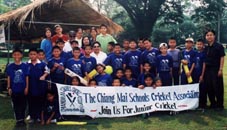 Students pose with President
Somboon Students pose with President
Somboon
Our own Eastern Seaboarders, the Pectels-69 cricket team, went to Chiang Mai to challenge for the honours at the Fourteenth Chiang Mai International Cricket
Sixes earlier this month. While they were not exactly covered with glory, nevertheless we can be proud of our team which travelled from the Jomtien-Pattaya seaside to the
Chiang Mai hillside to battle with some of the world’s best cricket sixes players. Against the mighty British Jack Frost team, led by former English test captain Mike Gatting,
for example, the Pectels lost by just two runs (74-0 to 76-0), Hemel Mendis the “Sri Lanka secret weapon” belting the maximum 35 before mandatory retirement. The Jack Frost
team went on to become runners-up of the Plate Division.
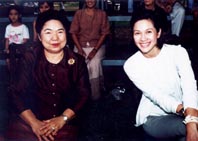 Dr Somboon and Kathaleeya: a great
show for Thai children Dr Somboon and Kathaleeya: a great
show for Thai children
That’s not cricket...
“That’s not cricket” was one of the cliches I most despised as a boy on the forbidding anglophile island of Tasmania. It was uttered for any situation
where the user had judged an action/deed to be not correct; it was tantamount to a condemnation of the perpetrator of whatever had taken place.
But, the following IS CRICKET, taken from an unknown source, to enlighten the uninitiated:
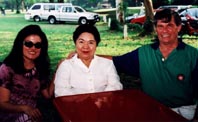 Organizers Maurice and Renita
Bromley sit with president of Chiang Mai Schools Cricket Association (CMSCA), Dr Somboon Suprasert: “Next year, 100 schools will play” Organizers Maurice and Renita
Bromley sit with president of Chiang Mai Schools Cricket Association (CMSCA), Dr Somboon Suprasert: “Next year, 100 schools will play”
“You have two sides - one out in the field and one in; each player that’s in the side that’s in goes out and when out comes in and the next player goes
in until out; when they are all out the side that’s out comes in and the side that’s been in goes out and tries to bowl/catch/stump those coming in out; sometimes there are
players still in and not out; when both sides have been in and out including the not-outs then that’s the end of the game.”
Quite simple, really!
The Pattaya Pectels
The Pectels is an eclectic Eastern Seaboard-based group of schoolteachers, golfers and retirees who have all, at one time or another, passed through the
pages of our Pattaya Mail. Captain Rob Roberts of West Indies descent is a science teacher at the International School of Pattaya. Steve Ross, like a check, is ALWAYS in
the Mail on the cutting edge of golf tournaments. Mark Allum is an English teacher at Assumption College and retiree Mike Phillips is also a golf enthusiast, as is
fellow-retiree Eddie Blackwell.
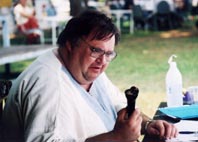 Rick Davis looks at his headless
mike: “I’m glad that was mike’s head and not Rick’s,” said the personable commentator Rick Davis looks at his headless
mike: “I’m glad that was mike’s head and not Rick’s,” said the personable commentator
Mike, Rob and Steve have challenged before - in the 1998 Sixes - when they fielding the dreaded “Banchang Bangers” and won the Spoon Division title that
year.
Skipper Rob requested to take advantage of this report, to thank publicly “all those individuals - especially Stan of Classroom fame and Bill from Rosie
O’Grady’s - who contributed to the purchase of football boots for students at the Tong Plung High School.
South Africans reign supreme
It was the South Africans who basically dominated the fourteenth edition of the Sixes, played at the charming century-old Chiengmai Gymkhana Club Cricket
Ground. The Hampton Hound Dogs won the Cup Championship, while neighbours on the African continent, a local Chiang Mai expatriate team composed of Zimbabweans and star batsman
South African test player D. H. Ackerman, won the Bowl title. The name of this team? The acronym “DIRTZ” spells out to mean “Difficulty in returning to Zimbabwe”.
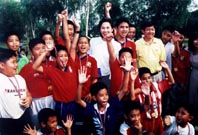 Budding Thai cricketers pose with
their idol, UNICEF Envoy Khataleeya McIntosh Budding Thai cricketers pose with
their idol, UNICEF Envoy Khataleeya McIntosh
Finally, South Africa, comprising five former school-mates, scored 88 for no loss to beat the “Rest of the World” for the Stars Challenge Cup.
Elsewhere, the mainly Aussie Schlungers, who have participated in every Sixes competition since the first in 1988, won the Spoon and the British Northern
Oiks won the Plate. The hard-fought Women’s competition saw the Chiang Mai Chassies take out the Women’s World All-Stars. Their post-game party at the cricket ground was a
joy to behold.
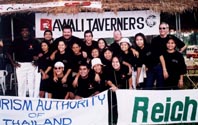 The Awali Taverners - and their
“cheerleaders” The Awali Taverners - and their
“cheerleaders”
The New Zealand presence took the form of the “Taranaki Taverners” from Plymouth, headed by former test cricketer, Alistair Jordan, who also had a son
playing in the team. New Zealander, detective inspector Peter Evans who attended the Sixes, added that he, “Looked forward to the return of the Kiwi Cavaliers next year,
under the able helmsmanship of Mark Bowyer.”
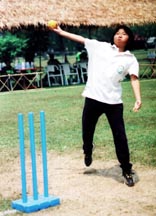 Little Apple shows a fine bowling
style in the Junior Championship Little Apple shows a fine bowling
style in the Junior Championship
Children’s cricket under the direction of Somboon Suprasert, who recently agreed to become co-chairman with Peter Dawson of the Chiang Mai Schools Cricket
Association, saw 10 teams entered in the Junior Cup this year. The two main rivals, the Thai schools Prince Royal College and Montford College were joined by smaller schools
and Dr. Somboon has promised 10 times this number for the 15th Sixes next year.
The standard of bowling, batting and fielding increased remarkably as the week progressed, resulting in extremely close games and two bowling
“hat-tricks” (a wicket taken from each of three successive balls), by Stuart Kaschula of Royal Selangor and Will Pickersgill of the Northern Oiks, respectively.
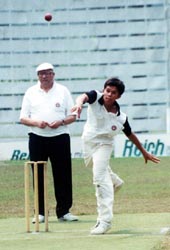 ‘Rookie’ of the match, Robert
Bromley shows a wicked wicket-taking form ‘Rookie’ of the match, Robert
Bromley shows a wicked wicket-taking form
There was also enthusiastic support from the sidelines as Australian Ambassador H.E. Miles Kupa came along to give moral support to his team the Southerners.
Meantime, at the other end of the Chiengmai Gymkhana Club cricket ground, a very vociferous group came in to support THEIR team, the Awali Taverners. The very shapely ladies
themselves were right out of the “Bunny Club” - invited, of course, because of their knowledge of the royal and ancient gam of cricket.
The batting, particularly, was - to say the least - vigorous, as sixes sailed high over the stands, knocked panels out of the site-screens and had spectators
and teams alike diving for cover. One specific “six” took the microphone right out of the hand of commentator Rick “Viking” Davis: the acoustic feedback was horrendous!
Some said it was retaliation for Rick’s daylong monologues, ranging in tone from hilarious to somewhat acidic.
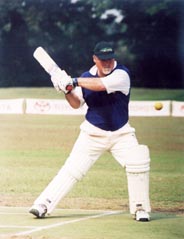 English Test captain Mike Gatting
about to slam the ball right out of the ground for a six English Test captain Mike Gatting
about to slam the ball right out of the ground for a six
Another ball landed on organizing committee chairman Maurice Bromley’s car, with a similar acoustic feedback: the ball landed so hard that it activated the
anti-theft device.
The UNICEF Youth Ambassador Khataleeya McIntosh presided over the afternoon awards ceremony, emphasizing the importance the tournament organizers -
especially the chairman of the organizing committee, Maurice Bromley - places upon introducing cricket to Thai children and young people to the teamwork, camaraderie and
discipline of cricket!
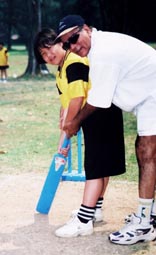 Coaches are very happy with
progress Coaches are very happy with
progress
So high was the enthusiasm among the children that, even after she had presented all the medals, the Youth Ambassador could not leave the beaming children
until she had signed EVERY tee shirt!
By the final day, many of the players had started to succumb to heat prostration - which, considering many of the players had come from colder climes still
in the grip of a bitter winter - was not surprising, as the Chiang Mai ambient temperature hovered around 40 degrees. One such was Mike Gatting who was hospitalized with a form
of cellulitis and was unable to lead his team Jack Frost into an all-English Plate final, in which Jack Frost went down to the Northern Oiks by nine runs.
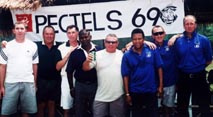 The famous Pattaya Pectels: next
year we shall win The famous Pattaya Pectels: next
year we shall win
The record number of 27 teams, plus two ladies combos - the “Chiang Mai Chassies” and the “Women’s World All-Stars” - descended onto the Chiengmai
Gymkhana Club Cricket Ground for the opening game of the day’s scheduled 13 - and, on two days, 14 - games which started at 8.30 and continued uninterrupted until dusk.
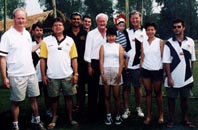 Australian Ambassador H.E. Miles
Kupa ‘dropped by’ to support his team, appropriately named the Southerners Australian Ambassador H.E. Miles
Kupa ‘dropped by’ to support his team, appropriately named the Southerners
Surapong Sukannasilp, chairman of the Gymkhana Club opened the Sixes, bowling a mean ball to world-renowned Sri Lankan test cricketer, Ramesh Rathnayake who
was suitably impressed with the chairman’s delivery, executed in office attire, even.
From its relatively humble beginnings in 1988, the Chiang Mai Cricket Sixes has now taken its place as one of the region’s major international cricket
competitions.
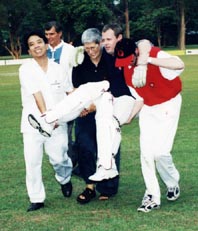 Heat prostration claims a victim Heat prostration claims a victim
“The Fourteenth Sixes,” according to Bangkok Post correspondent Jim Hawker, “was the best ever - with test stars and amateurs playing
side-by-side – and hectic social activity providing a perfect mix, through the efforts of the hard-working committee headed by Maurice and Renita Bromley and co-ordinators
Rick Davis, Mike Mmher” and the tireless dedication of Sixes addict, Geoff Thompson. This correspondent agrees entirely.
Maurice’s own enormous input was rewarded when his handsome, personable and very polite 14-year-old son Robert played for the Cup Winners “Hampton Hound
Dogs”, becoming the youngest player ever to have been in a Cup winning team in the Chiang Mai Sixes 14 year history. He was also named “best rookie of the tournament”,
having taken three wickets from four balls on two consecutive days.
Although the Aussie team, the Warathais was eliminated in the second Cup semi-final, the New South Welshmen had the satisfaction of seeing skipper Steve
Christie named “Player of the Tournament”.
Sponsorship was generous as usual, such as the Tourism Authority of Thailand, the Amari Rincome, Castrol, the Chiang Mai Municipality and the Reich Company
which, again, provided totally-reliable transport allocated to more than 30 groups.
So Pattaya Pectels, start practicing for next April!
Results
Cup: Hampton Hound Dogs (84-0, J. Kaminski 33 ret.; J. Commins, 23 n.o.) def. Perth Postels (P. Andersen, 35 ret.; K. Jackson, 30
ret.).
Bowl: DIRTZ (50-1) def. Royal Selangor (49-3, F. Fernando, 32 ret.).
Plate: Northern Oiks (80-0, C. Hartdford-Cross, 32 ret.; M. Fettes, 31 n.o.) def. Jack Frost (76-1, N. Billing, 33 ret.).
Spoon: Schlungers (d. Nitschke, 34 ret.: M. Mayo, 31 ret.) def. IOS Malakas (82-4).
Stars Challenge: South Africans (88-0, K. Jackson, 30 ret.) def. Rest of the World (R. Ratneyeke, 35 ret.; D. Ward, 31 ret.).
Ladies Challenge: Chiang Mai Chassies (48-2, P. Marsh 15 ret.) def. Women’s World All-Stars (45-2, S. Watson, 16 ret).
The Ban Reng Khai silk weaving project
A village progressing through a Dutch woman’s vision
Ban Reng Khai is a very small community in Surin Province that was started by three couples fifty years ago. It now has fifty-three families with a
population of around 400 people. The catalyst for its expansion and development has been an amazing Dutch woman, Lea Dingjan-Laarakker.
When Lea first went there in 1987 the hamlet was so small, it didn’t even have village status. Ever practical and undeterred Lea made it her project to
help Ban Reng Khai become self-supporting. What she has achieved since has been nothing short of a miracle. The main financial underpinning of the self-sufficiency of the
village was the introduction of a silk weaving and silk painting project. It is creative and successful and gives the local women choices - but first she had to establish
basic survival facilities where none existed before.
 Rice was their main crop but it was very labour intensive. The soil is poor there
and will only sustain one crop a year. Moneylenders lend money with the rice farms as security with the usurer’s interest rate of 5-10% per month. If the loan in not repaid
in full in three years then the rice farms are repossessed. The result is the usual grinding poverty and the drift of the young to the cities to get more work. Rice was their main crop but it was very labour intensive. The soil is poor there
and will only sustain one crop a year. Moneylenders lend money with the rice farms as security with the usurer’s interest rate of 5-10% per month. If the loan in not repaid
in full in three years then the rice farms are repossessed. The result is the usual grinding poverty and the drift of the young to the cities to get more work.
Lea spent the first two years just talking to the men and women of the village to accustom them to the idea of becoming self-supporting. Lea smiled
ruefully and said, “This resistance is natural if you are bought up in a society with the idea of relying on the children for support.” Lea was instrumental in achieving
“Thai village” status so that Ban Reng Khai could qualify for more facilities. With the help of Zonta International she raised 80,000 baht in fourteen days because if
every house had a toilet within a fortnight each person could get a security card.
One of her first projects was to raise 500 guilders from Rotary, Lions and a Women’s group in the Netherlands for a water pump. “The pump was blessed
by the monks so it was christened The Holy Pump,” she said smiling at the memory.
The village had abundant rainfall but not enough storage jars to tide them over the dry season - Project Water was completed in 1992. Lea herself raised
the money and an organization called Wild Goose built 180 fish ponds, adding essential protein of catfish to the villagers diet. Previously, the protein mainstay of the
village people’s diets had been rats. “Now these are healthy country rats eating only rice and vegetables,” Lea told an incredulous audience of Pattaya International
Ladies Club members when she addressed them here.
With amazing vision Lea worked to commence a study foundation for education. “The study foundation provides uniforms for the children and financial
support for the families to allow the children to attend school.” She even reintroduced an old Thai system of a Rice Bank with 5% interest a year, so the villagers could
borrow and repay rice and manage their own savings and insurance funds.
Setting herself incredible targets, Lea commenced an agricultural fund and also medical assistance with three government nurses and two Thai development
teachers. Hygienic food preparation and many improvements in the daily aspects of village life are taught. However, education in family planning took longer. “The husband
as the head of the family was convinced he had to take the contraceptive pill,” said Lea.
Lea even raised money to help fund the purchase of 200 buffaloes. “I bought some myself,” she laughed, “They do not need a lot of money to
maintain.” In response to my amazement at both the vision and enormity of the village project Lea said simply, “I am a farmer’s daughter and I have always been
interested in women’s affairs.”
“It was always our aim to help the people to help themselves to produce an improved lifestyle, leaving their own choice to leave or stay. If you make a
cottage industry in a village with no factory, then you have good quality control of the product. No factories are an environmental plus too, making enjoyment of traditional
lifestyles really possible. Importantly, if you re-introduce and maintain old traditions you are allowing the people to develop and express their own creativity and pride.
People are always more peaceful in their mind if they learn to use their creativity.”
In 1992 Lea co-wrote a book on the village Ban Reng Khai with renowned Thai author Pira Sudham contributing a story called “A farmer and his wife.” The
book was written and superbly photographed with the aim of both supporting village projects and to encourage the curious to be able to see the villagers at work.
Lea says in her introduction, “Our aim with Ban Reng Khai village has always been and still is to make the village self supporting. Having reached a
sufficient level of independence the people will then be in the position to take their lives and their future into their own hands, unhindered by poverty, poor health and
lack of education.”
When Lea first visited the surrounding province she noticed that the region was still producing the “Surin silk” woven from a rather thick thread.
Although Ban Reng Khai had stopped producing, the elderly women had not forgotten the art. Lea said, “Many of the men are quite good carpenters and we had a community
weaving hall and a number of looms built. Raising silk worms had not been successful so we bought the warp from Petchburi from a Dutch aided community project there. A
starting quantity of raw silk yarn was bought and the older women started weaving. The quality improved, young women joined and in 1992 we had about 24 weavers who were
producing up to 1500 meters of silk.”
This self-help (with guidance) has been very successful for the villagers and the foundation has now managed to fund secondary education for more than 500
young people from the surrounding areas. Ban Reng Khai is making it into the 21st century, and most of this has been made possible by a far sighted Dutch woman, some
silkworms and abundant native Thai skills. An amazing partnership.
BCCT to hold International Networking Evening
The BCCT has extended and open invitation for the next “International Networking Evening on the Eastern Seaboard” at Shenanigans, Royal Garden Plaza,
Pattaya 2 Road, Pattaya on Friday 27 April 2001 from 6:30 to 8:30 p.m.
All are welcome to attend regardless of nationality. The main objective is to provide an opportunity for networking for business people based in the
Eastern Seaboard area.
Global Silverhawk/Santa Fe is sponsoring Carlsberg Beer, soft drinks and some cocktail food. All other drinks are at standard prices as will Carlsberg when
the sponsored supplies have run out. There is no fee for this pub night but only those wearing business cards will be supplied with sponsored drinks and food. Name
cardholders will be provided on the door.
Please reply to the British Chamber of Commerce Thailand, fax: +662-651-5354, tel. +662-651-5350-3, email: [email protected]
Packed houses at White Night and Top Man Club on Saturday April 14
Bring in 120,000 Baht for charity
Jim Lumsden acted as Master of Ceremonies for the Pattaya Gay Festival (PGF) buffet and show at White Night Restaurant and Top Man Nightclub in Sunee Plaza
on Saturday night, April 14. Jim is also the originator of the PGF and has participated fully in every activity of the PGF. He reports as follows:
“Top Man and White Night Buffet was a spectacular success. They sold over 80 tickets and both the restaurant and bar were filled to capacity. The
entertainment was superb and particularly Emma and Pat’s wonderful duo which had everyone laughing from beginning to end. The shows from Tiffany, Alcazar, Icon, Boyz Boyz
Boyz and Throb were carried off in true style. I can’t fail to mention the Top Man Nightclub’s own in-house show which was, as expected, perfect in every detail. I was
thrilled to be asked to act as MC for the evening and I had a great time working with the Top Man team. Michael and Tony have now added another 120,000 baht to the PGF
charity funds. A great big thanks to everyone that showed up Saturday night and again dug deeply into their pockets. The continuing generosity seems to know no bounds.”
Michael Burchall of Top Man donated a VCR and a television set as top prizes for the raffle, and in addition donated baht 10,000 personally. Jim Lumsden
also donated 15,000 personally. The performances included 5 separate acts by Madame Jim, with full costume changes, which earned mountains of applause.
The next event on the Pattaya Gay Festival is the BBQ and Games Night at Tui’s Place in Jomtien Beach on Saturday April 28, co-sponsored by Tui’s Place
and by Throb Nightclub, scheduled with volleyball games starting in the morning, and expected to continue through much of the day, and the barbecue dinner at 7:30 p.m.,
followed by stage performances by many local groups.
Antiques, Are They Genuine?: Methods of Manufacture
by Apichart Panyadee
Wrought iron was worked in a forge by the blacksmith. Joints were made either by fusing the iron bars together under intense heat or by riveting them.
Shapes were created by bending the hammered bars around angles on the anvil. Everything was individually produced and each item, however skilfully made, differed slightly
from the next.
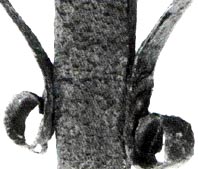 True appearance of wear and oxide
on wrought iron True appearance of wear and oxide
on wrought iron
Each blacksmith would make his own bars for further shaping into tools and objects he wished to make. Thus, all the iron used was hand made and slightly
uneven. Modern wrought iron is made from pre-shaped bars. However, Asian blacksmiths making fakes tend to follow the old methods and make their own forged iron.
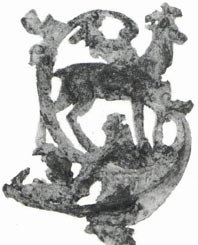 Small fragment of 16th century cast iron from a set of
gates Small fragment of 16th century cast iron from a set of
gates
When iron was cast into household objects, some were made in moulds, but widespread use was also made of open sand casting. Firebacks, for example, were
made by stamping the decoration in casting sand, and pouring the melted iron directly into the open boxes. Early firebacks are generally very thick; an inch or more, but
modern founders were more sparing with their ore.
The Metal
It is possible to analyse iron and steel and determine the proportions of carbon they contain. This helps with dating. The nature of the impurities iron
holds can also identify the fuel used in its forging and therefore help to date the hearth used in its manufacture. Wrought iron is hard to date by analysis as the methods
used remained the same over a long period of time and only the use of modern iron now distinguishes today’s blacksmith’s work from earliest productions.
Maker’s and other marks
Many 19th century and earlier blacksmiths signed their work, but there is no book which can help identify where or when they worked. Local records would
have to be consulted if a particular blacksmith’s work is to be identified. Owner’s initials, marks or inscriptions are seldom found on ordinary items.
Condition
Iron tends to oxidise rather quickly, so it is not difficult to give a wrought iron object the appearance of age. Wear, on the other hand, is no so easy to
copy. Fakers often simulate indiscriminately. Look for wear at the points where an object would have been put to maximum use. The surface of wrought iron ought to be
genuinely worn by a combination of oxide, cleaning, repainting, and wear. This cycle will be repeated frequently over the object’s working life. Genuine wrought iron
usually has a pitted and mottled appearance, even if it has been cleaned. Look for evidence of use and deterioration. Most reproductions will be rusted, but not truly worn,
impacted and corroded.
An evening with Deputy Commerce Minister Dr. Suvarn Valaisathien
Wednesday, May 9, 8pm
The FCCT will be hosting an evening with Deputy Commerce Minister Dr. Suvarn Valaisathien on Wednesday, May 9, at 8 p.m. Dinner from 7 p.m., Bt 280
members; Bt 400 non-members; non-member entry only Bt 250.
Dr. Suvarn is on the cutting edge of the new government’s investment policies. The words of the highly active minister are starting to be viewed as a
barometer for the government’s attitudes towards new foreign investment.
Therefore, existing and potential foreign investors in particular should mark May 9 in their diaries as an FCCT special programme evening not to be missed.
Dr. Suvarn has agreed to outline the government’s policies and answer your questions.
Copyright 2001 Pattaya Mail Publishing Co.Ltd.
370/7-8 Pattaya Second Road, Pattaya City, Chonburi 20260, Thailand
Tel.66-38 411 240-1, 413 240-1, Fax:66-38 427 596; e-mail: [email protected]
|

The Rotary Club
of Jomtien-Pattaya

Skal
International

Pattaya
Fun City
By The Sea
|
 Students pose with President
Somboon
Students pose with President
Somboon Dr Somboon and Kathaleeya: a great
show for Thai children
Dr Somboon and Kathaleeya: a great
show for Thai children Organizers Maurice and Renita
Bromley sit with president of Chiang Mai Schools Cricket Association (CMSCA), Dr Somboon Suprasert: “Next year, 100 schools will play”
Organizers Maurice and Renita
Bromley sit with president of Chiang Mai Schools Cricket Association (CMSCA), Dr Somboon Suprasert: “Next year, 100 schools will play” Rick Davis looks at his headless
mike: “I’m glad that was mike’s head and not Rick’s,” said the personable commentator
Rick Davis looks at his headless
mike: “I’m glad that was mike’s head and not Rick’s,” said the personable commentator Budding Thai cricketers pose with
their idol, UNICEF Envoy Khataleeya McIntosh
Budding Thai cricketers pose with
their idol, UNICEF Envoy Khataleeya McIntosh The Awali Taverners - and their
“cheerleaders”
The Awali Taverners - and their
“cheerleaders” Little Apple shows a fine bowling
style in the Junior Championship
Little Apple shows a fine bowling
style in the Junior Championship ‘Rookie’ of the match, Robert
Bromley shows a wicked wicket-taking form
‘Rookie’ of the match, Robert
Bromley shows a wicked wicket-taking form English Test captain Mike Gatting
about to slam the ball right out of the ground for a six
English Test captain Mike Gatting
about to slam the ball right out of the ground for a six Coaches are very happy with
progress
Coaches are very happy with
progress The famous Pattaya Pectels: next
year we shall win
The famous Pattaya Pectels: next
year we shall win Australian Ambassador H.E. Miles
Kupa ‘dropped by’ to support his team, appropriately named the Southerners
Australian Ambassador H.E. Miles
Kupa ‘dropped by’ to support his team, appropriately named the Southerners Heat prostration claims a victim
Heat prostration claims a victim Rice was their main crop but it was very labour intensive. The soil is poor there
and will only sustain one crop a year. Moneylenders lend money with the rice farms as security with the usurer’s interest rate of 5-10% per month. If the loan in not repaid
in full in three years then the rice farms are repossessed. The result is the usual grinding poverty and the drift of the young to the cities to get more work.
Rice was their main crop but it was very labour intensive. The soil is poor there
and will only sustain one crop a year. Moneylenders lend money with the rice farms as security with the usurer’s interest rate of 5-10% per month. If the loan in not repaid
in full in three years then the rice farms are repossessed. The result is the usual grinding poverty and the drift of the young to the cities to get more work. True appearance of wear and oxide
on wrought iron
True appearance of wear and oxide
on wrought iron Small fragment of 16th century cast iron from a set of
gates
Small fragment of 16th century cast iron from a set of
gates
